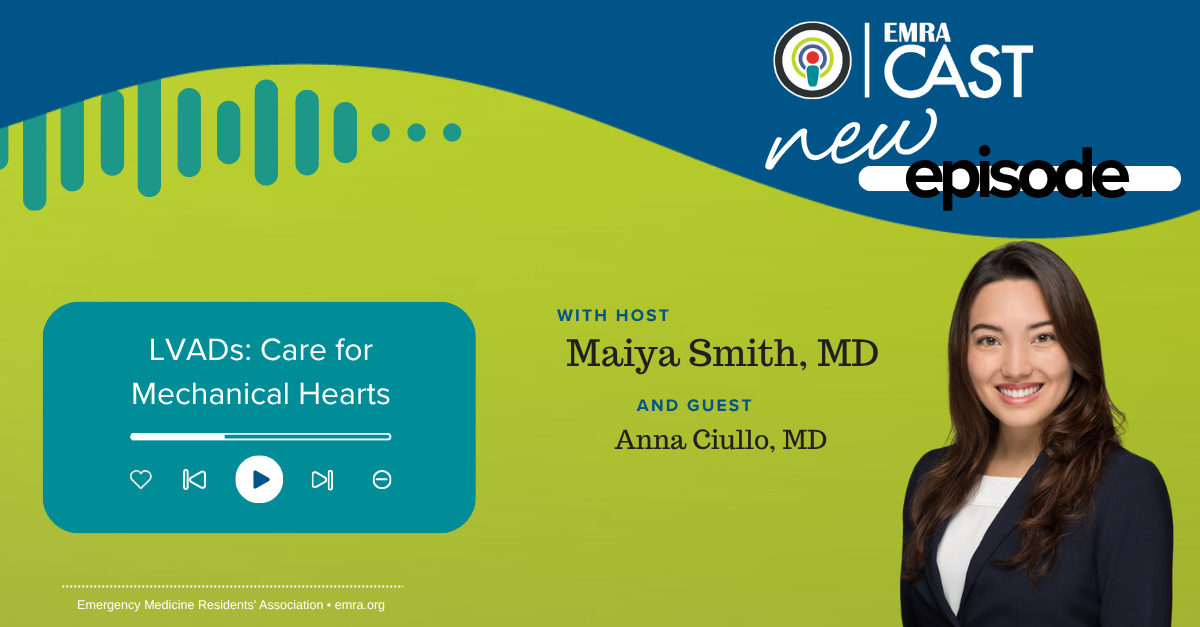LVADs: Care for Mechanical Hearts
LVADs: Care for Mechanical Hearts
Nov. 15, 2025
LVADs can rattle even seasoned docs. Dr. Anna Ciullo (X: @aciulloMD) breaks down what to do when one shows up in your ED: how to assess perfusion, manage complications, and decide on CPR. From pump thrombosis to GI bleeds, we help you stay calm and take control. Join host Dr. Maiya Smith for this conversation.
Host
Maiya Smith, MD
University of Utah
Emergency Medicine Residency Class of 2025
@Maiyaandtheadventuremutts
EMRA*Cast Episodes
Guest
Anna Ciullo, MD
University of Utah
Division of Cardiothoracic Surgery
Department of Emergency Medicine
X: @aciulloMD
OVERVIEW
Whether you’re days from becoming an attending or just trying to figure out how to get a BP on a pulseless patient, this episode will help you go from fear to confidence in managing LVADs in the emergency department. Join EMRA*Cast host Dr. Maiya Smith and guest Dr. Anna Ciullo as they review how to assess perfusion, manage complications, and decide on CPR. From pump thrombosis to GI bleeds, we help you stay calm and take control.
Summary
Patients with LVADs can quickly become scary situations for residents (or even seasoned EM docs). But as Dr. Anna Ciullo reminds us: the LVAD is just a machine, and we can learn how to manage it.
In this episode, Dr. Ciullo breaks down everything from what an LVAD is to how to assess a crashing LVAD patient. We cover:
- LVAD components and indications
- Clinical assessment of the LVAD patient
- Recognizing and managing LVAD emergencies
- CPR in LVAD patients
- Why early contact with the LVAD coordinator might just save your patient (and your sanity)
Whether you're days from becoming an attending or just trying to figure out how to get a BP on a pulseless patient, this episode will help you go from fear to confidence in managing LVADs in the ED.
Objectives
- Define the function and core components of a Left Ventricular Assist Device (LVAD), including the pump, driveline, controller, and power source.
- Recognize common LVAD complications such as GI bleeding, driveline infections, pump thrombosis, and right ventricular failure.
Identify how to clinically assess the LVAD patient - Summarize the current AHA guidelines regarding chest compressions in LVAD patients and describe when CPR is appropriate.
References
- Chaudhry A, Berberian JG, Gandhi N. Emergency Department Approach to LVAD Patients. EM Resident. 2025;52(1):6-10.
- Peberdy M, Gluck JA, Ornato JP, et al. Cardiopulmonary Resuscitation in Adults and Children With Mechanical Circulatory Support: A Scientific Statement From the American Heart Association. Circulation. 2017;135(24): e1115-e1134.





